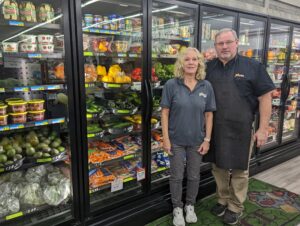Sheep graze on a local solar farm at White Oak Pastures in Bluffton, Georgia
April 05, 2023
Restoring Communities through the Rural Energy for America Program
Rural America is in the midst of a crisis. Congress has the tools to fix it.
By Brandon Watson
Rural small businesses and farms face a deepening crisis. The agriculture industry is increasingly dominated by a handful of large and sprawling companies, pushing out and supplanting smaller operators. Depopulation in rural areas continues to reduce the potential for future growth and job opportunities. This perpetuates a feedback loop of business closures, job loss, and disinvestment in some of the most economically distressed regions of America.
However, the upcoming Farm Bill provides local rural communities with vital investment through the Rural Energy for America Program (REAP). The recently passed Inflation Reduction Act, allocating $2 billion in REAP funding over 10 years, is a step in the right direction that shows Congress is aware of the need to act.
With additional policies suggested by ELPC for the Farm Bill – included in our 2023 REAP success stories report – IRA improvements on the REAP program can become permanent.
Stronger businesses, stronger communities
Beresford is a small town in South Dakota where nearly half of the students are on free or reduced lunch. Grocery stores in nearby regions have either closed down or are struggling, leaving residents driving miles to find fresh food. That makes Brian and Rhonda Peterson’s full-service Fiesta Foods important not just for the town, but the entire southeast tip of South Dakota.

Rhonda and Brian Peterson’s new, energy-efficient refrigerators save the Fiesta Foods rural grocery store in Beresford, South Dakota, between $1,200 and $1,300 a month in energy bills.
A REAP grant let the Petersons overhaul their refrigerators for more energy efficiency. This cut their energy bill by $1,200 to $1,300 per month and reduced their repair and food costs, keeping their business profitable and open for residents.
“It’s a must to keep [REAP] going for these small-town retailers and farmers,” Brian Peterson said, “because once you start losing your small business in these small towns, you don’t have a lot of town left.”
Fiesta Foods shows that preserving and expanding small businesses is essential to rural Americans’ quality of life. A high return on investment from REAP projects allows owners to reinject money into their communities, increasing the appeal for newcomers as well as current residents’ living standards.
Bluffton, Georgia, proves this.
Clay County, where the town is located, was once one of the poorest counties in the nation. Will Harris – owner of White Oak Pastures – remarked that there were barely enough kids in town to make a full football team. However, White Oak Pastures has since become the largest employer in the county. The farm increased from 3 to 180 workers who are paid twice the county average, pumping $100,000 into the local economy every week and encouraging people to return to the region.
Harris expanded his farm through REAP grants for energy efficiency and solar power. He plans to have 3,800 acres of solar farm available to local farmers for sheep grazing. This helps young farmers get started and overcome land availability barriers, giving them room to learn and grow their operations.
More education, outreach needed
REAP is in an odd position, despite a 20-year track record of bringing jobs and money to communities like Beresford and Bluffton. It is massively popular, with requests for grants historically outstripping funding. The recent investment in REAP from the Inflation Reduction Act shows that lawmakers recognize this interest.
Yet many in the agriculture community are still unaware of the opportunities REAP offers.
That was the case for Smiley Farms in Greensburg, Indiana. The 1,100-acre farm, owned and operated by the Smiley family since 1956, suffered from a large and destructive fire in 2017. Brothers Jeff and Gordon Smiley heard about REAP from a neighbor during their reconstruction efforts. They used a REAP grant to cover part of the costs of 46 energy-efficient variable frequency drives, saving them thousands of dollars a year on their power bills.
“We knew the energy bills weren’t going to get any cheaper,” Gordon Smiley said. “So, we thought, let’s be proactive.”
A program that can have such a great impact on rural economies and communities can’t rely on word of mouth alone. If Congress wants to ensure rural America can recover and regain its prosperity, they must focus on education and outreach efforts in addition to funding. Proposed project development assistance and technical assistance funding will help spread the word and organize “helper teams” to allow more rural small businesses and agricultural producers to take advantage of these opportunities.
Leveraging existing rural community relationships such as those between the Smiley brothers and their neighbors is a simple and effective way to promote the program. This includes involving local entities such as universities or electric cooperatives to spread awareness and provide support.
Investing in technical assistance and energy audits for prospective project owners and simplifying applications will also ensure that anyone can participate. Harris, the Petersons, and the Smiley brothers are among the thousands of success stories REAP has helped create in rural areas in every state in the nation. The influx of funding from the Inflation Reduction Act coupled with incorporating smart policy recommendations into the upcoming Farm Bill can ensure thousands more.
The opportunity for greater success is there. Congress just has to tap into it.
Brandon Watson is a Science and Policy Intern in ELPC’s Madison office.

